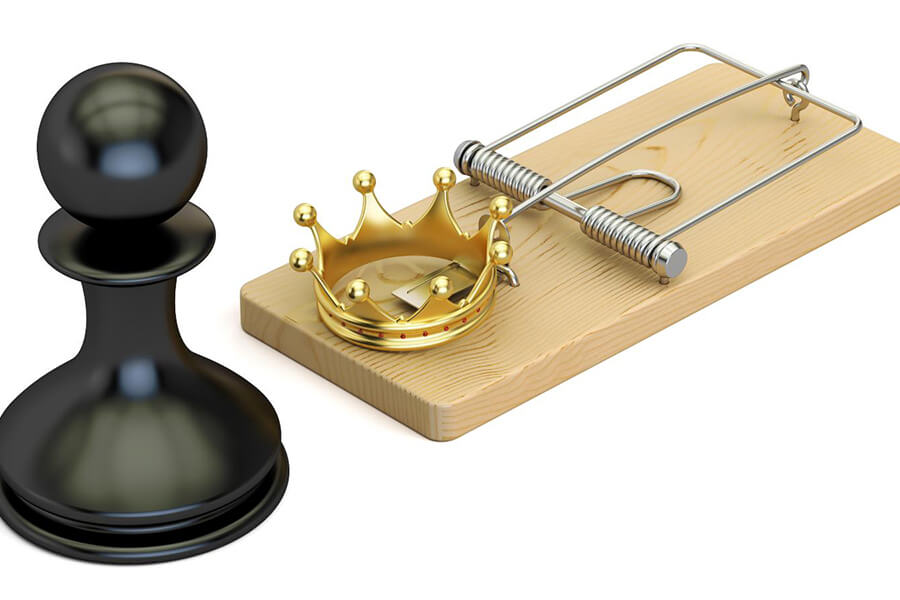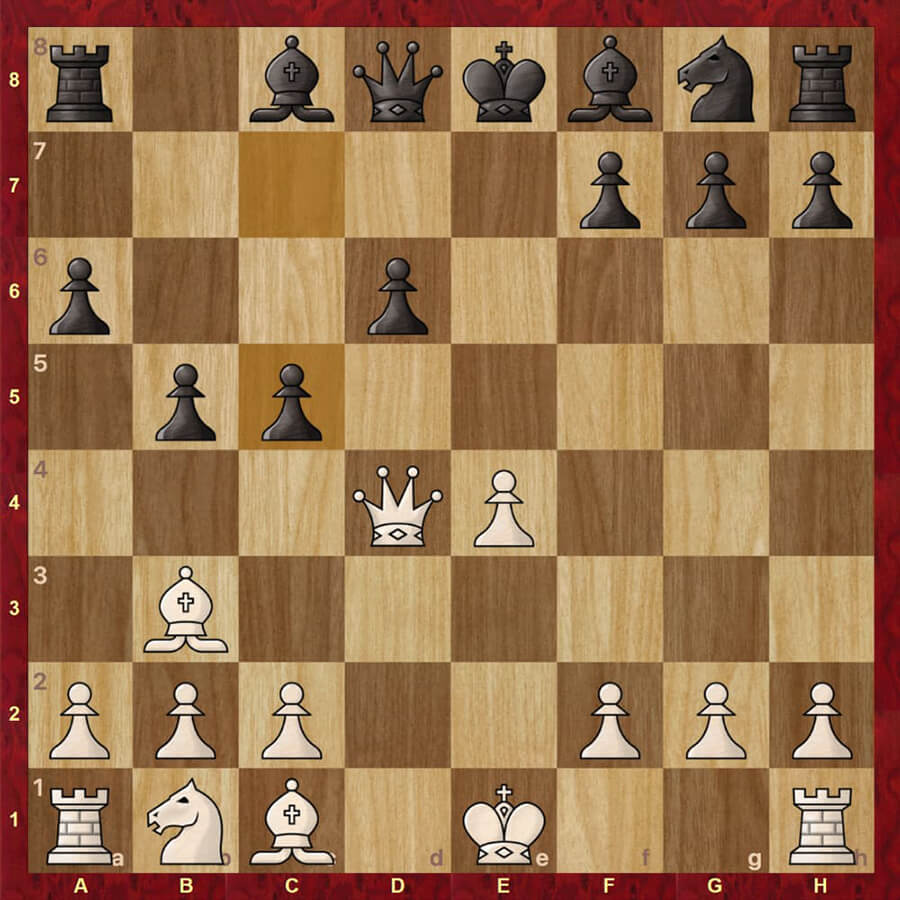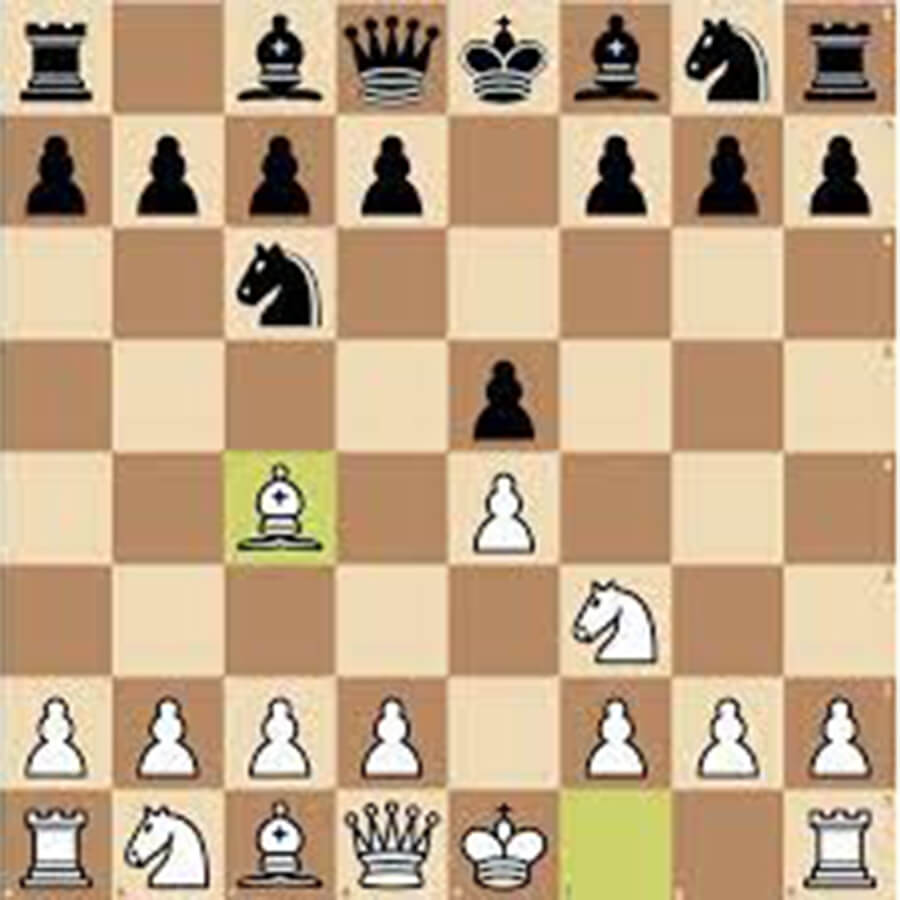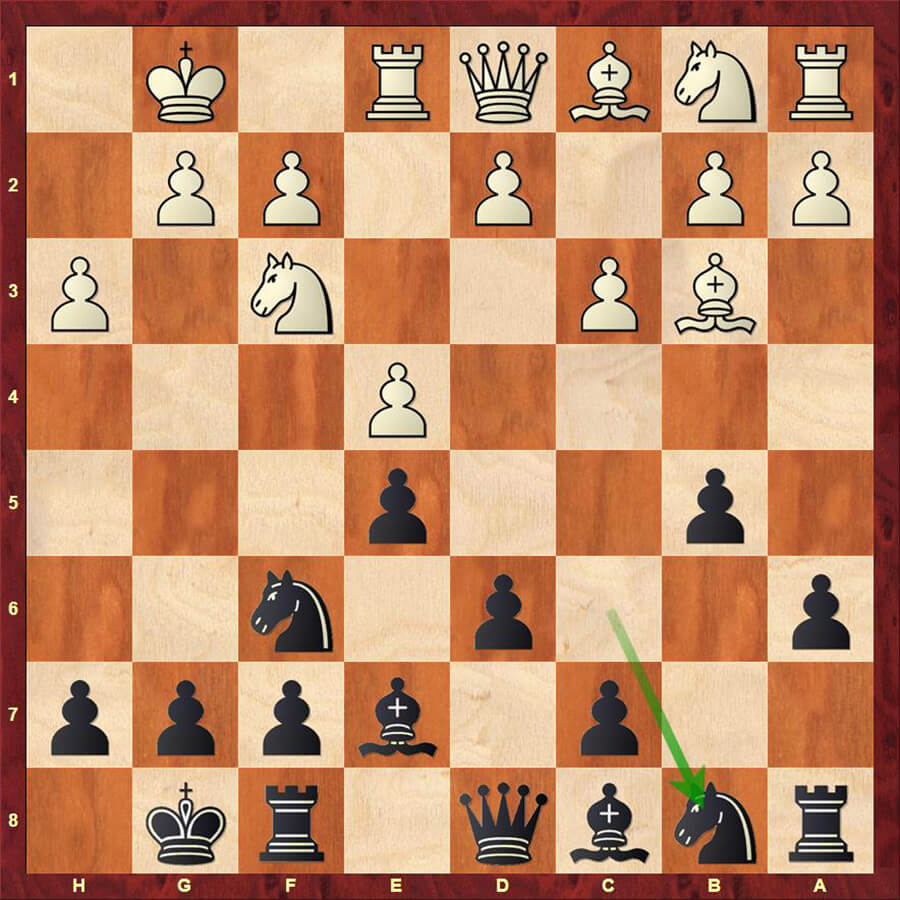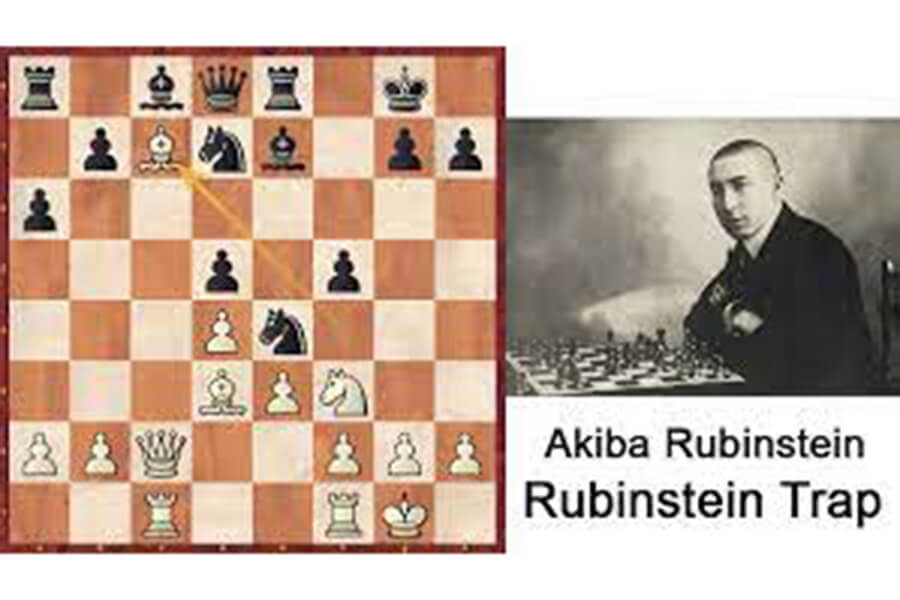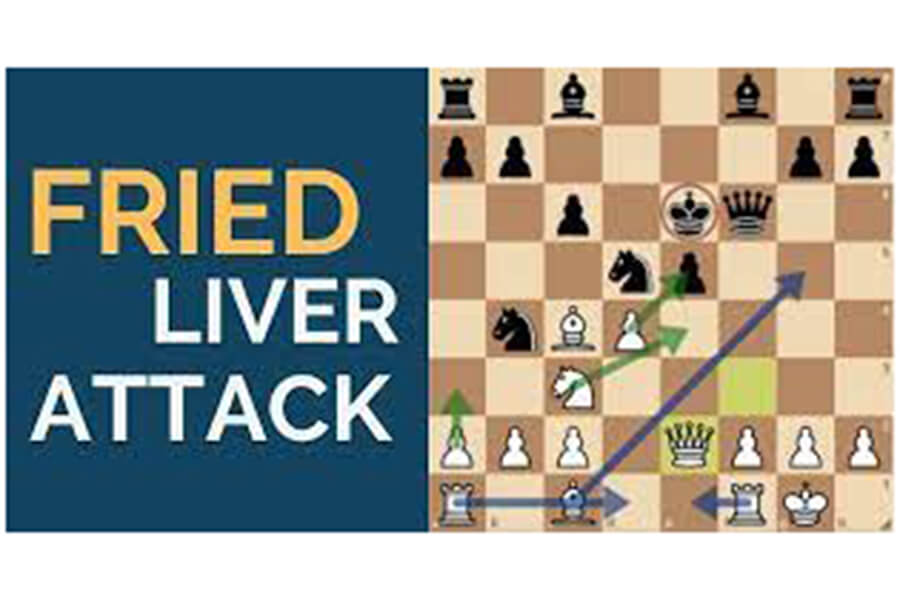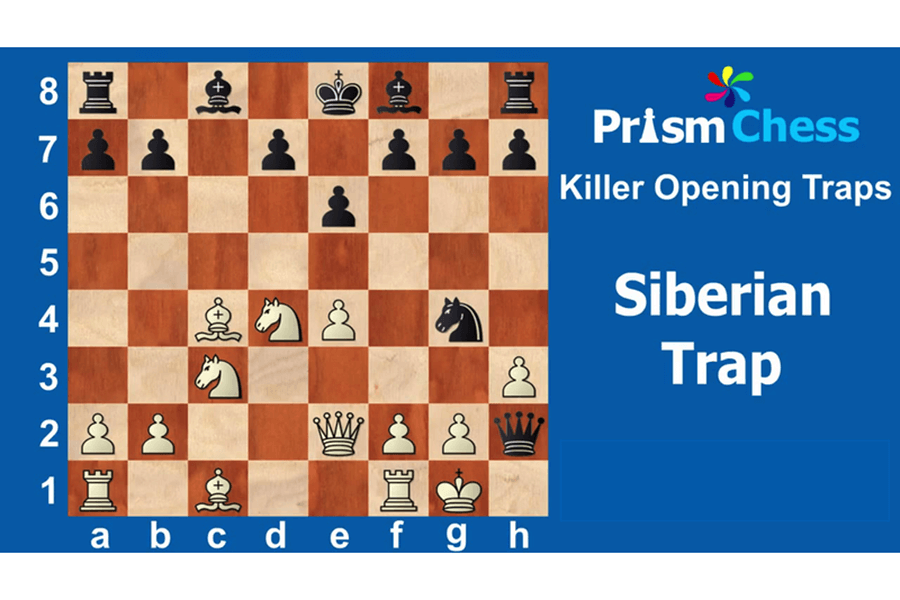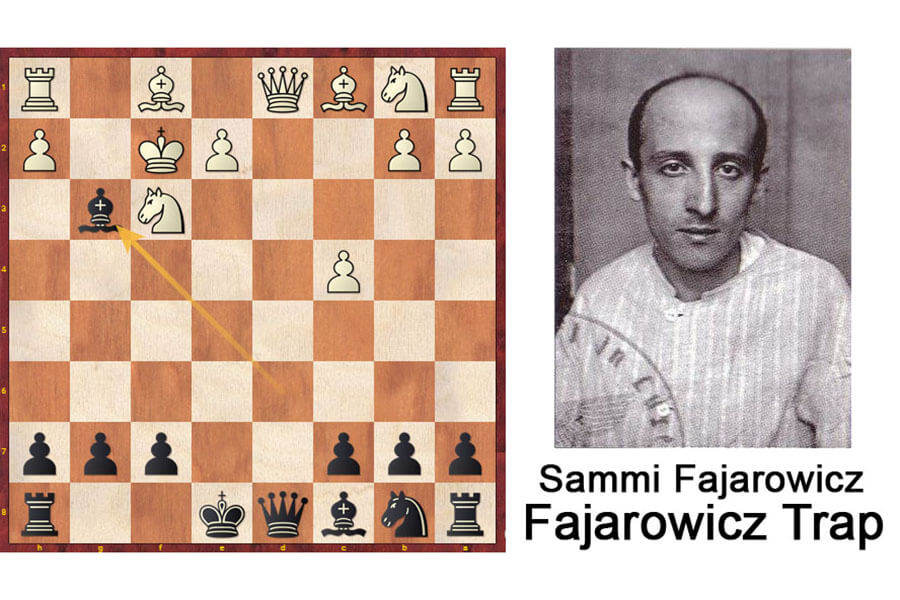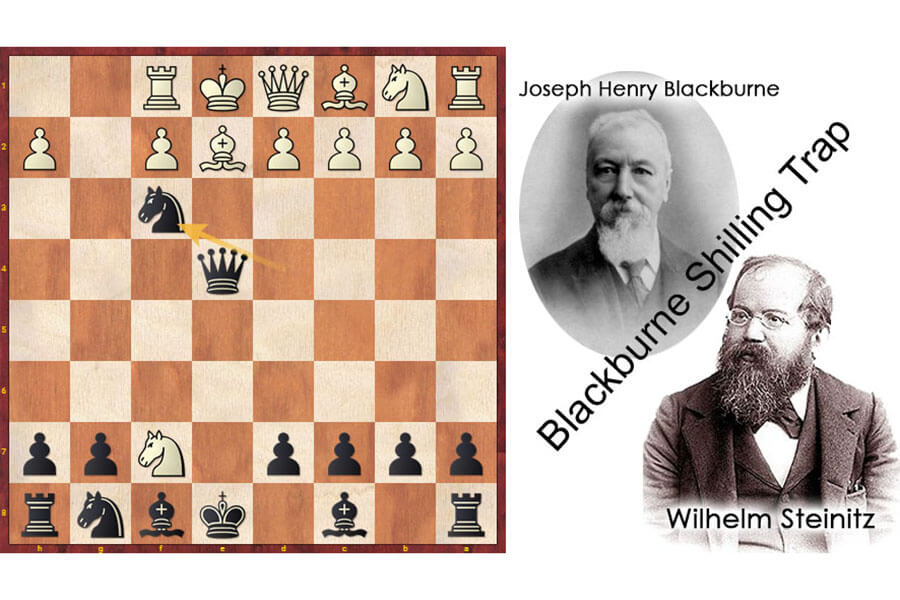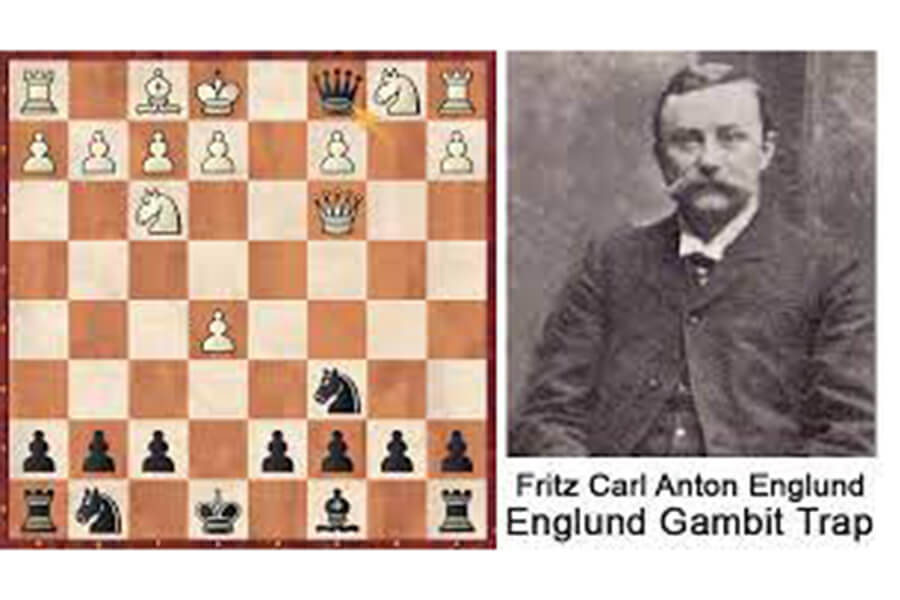No products in the cart.
Chess Rules & Instructions
Top 10 Traps Every Chess Player Should Know!
As long as Chess has been played, tricks and traps always bring creativity and being enjoyed by the players. A good chess trap presents tactical ideas, combinations, and concepts that capture our attention and test our patience. The chess traps in this article will give you some ideas you can apply to your game!
Table of Contents
Noah’s Ark Trap
The Noah’s Ark Trap is a common trap in the game of chess that can be used to trap an opponent’s bishop. It is typically seen in the Italian Game opening, where White sets a trap by moving their knight to c3.
Here is a possible variation of the trap:
1. e4 e5
2. Nf3 Nc6
3. Bc4 Bc5
4. O-O d6
5. d3 Bg4
6. h3 Bh5
7. Nc3 Nd4?!
8. g4 Bg6
9. Nxd4 Bxd4
10. Ne2 Bb6
11. Kg2 h5
12. f4 hxg4
13. hxg4 Qh4
14. Ng3 Qh2+
15. Kf3 Rh3
16. Qe1 Nf6
17. f5 Bh5
18. gxh5 Nxh5
19. Rg1 Bxg1
20. Qxg1 Rxg3+
21. Qxg3 Qxg3+
22. Ke2 Qg2+
23. Kd1 Ng3
24. Bd2 Qe2+
25. Kc1 Qf1+
In this variation, Black falls into the trap by playing 7… Nd4, which attacks White’s bishop on c3. However, after 8.
Legal Trap
This trap is all the way from the 18th century and named after Sire de Legal. The favorite trap for most chess players involves a beautiful queen sacrifice.
A “legal trap” in chess is a tactic used to lure an opponent into making a legal move that seems logical but actually leads to a disadvantageous position. The opponent may not realize the implications of their move until it is too late, and the player who set the trap can capitalize on the mistake.
Breyer Trap
One of the most common traps in the Caro-Kann Defense opening is the “Breyer Trap.” This trap arises after the moves
1.e4 c6
2.d4 d5
3.Nc3 dxe4
4.Nxe4 Nd7
5.Ng5 Ngf6
6.Bd3 e6
7.N1f3 h6?? (the critical mistake)
8.Nxe6! fxe6
9.Bg6+ Ke7
10.O-O
White sacrifices the knight on e6 to expose Black’s king and gain a strong attacking position. Black’s best move in this position is to play 7…Nb6, avoiding the trap altogether. It’s important for Caro-Kann players to be aware of this trap and play carefully in the opening.
Rubinstein Trap
The Rubinstein Trap is a common trap in the French Defense opening in chess. It occurs when white captures the black pawn on c5 with their bishop on move 3, and black responds with the move Qb6, attacking the white pawn on b2 and threatening checkmate on f2.
White’s natural response is to defend the pawn on b2 with a3, but this move allows black to play Na6, attacking the bishop on c5 and threatening to win it on the next move. If white captures the black knight with their bishop, black can play d4, forking white’s bishop and knight and winning a piece.
Therefore, the best move for white after Qb6 is to simply play Nc3, defending the pawn on b2 and avoiding the Rubinstein Trap.
Fried Liver Attack
One trap to watch out for in the Sicilian Defense opening is the “Fried Liver Attack.” This trap occurs when White plays the aggressive move Ng5, attacking Black’s f7 square. If Black responds with Nxd5, White can play the surprising move Nxf7, sacrificing their knight to open up Black’s king position. If Black takes the knight with their king, White can follow up with a strong attack and gain a significant advantage. To avoid this trap, Black should be cautious about exchanging pawns and knights in the opening and should keep their king protected.
Siberian Trap
The Siberian Trap is a chess opening trap that can occur in the Sicilian Defense. It usually happens in the Open Sicilian variation when White plays the move 2.Nf3 and Black responds with 2…d6.
The trap arises when White plays the move 3.d4, offering a pawn to Black. If Black takes the pawn with 3…exd4, White can play 4.Nxd4, attacking the pawn on d4. If Black now plays 4…Nf6, White can play 5.Nc3, attacking the knight on f6 and threatening to win it with Nd5.
If Black falls into the trap and plays 5…Be7, White can now play 6.Bb5+, attacking the king on f8 and forcing it to move. If Black plays 6…Nbd7, White can play 7.e5, attacking the knight on d7 and threatening to win a piece. Black will be in trouble and may end up losing material.
Therefore, Black should avoid taking the pawn on d4 and instead play 3…Nc6 or 3…a6, which are safer moves.
Fajarowicz Trap
The Fajarowicz Trap is a chess opening trap that can be used against the Sicilian Defense. It is named after the Polish chess master Wlodzimierz Fajarowicz.
The trap occurs in the following moves:
1.e4 c5
2.Nf3 d6
3.d4 cxd4
4.Nxd4 Nf6
5.Nc3 Nc6
6.Bc4 Qb6
7.Nb3 e6
8.Be3 Qc7
9.f4 a6
10.Bd3 b5
11.Qf3 Bb7
12.O-O-O Be7
13.g4 Na5
14.Kb1 Nc4
15.Bc1 Nd7
16.g5 Nc5
17.f5 e5
18.f6 gxf6
19.gxf6 Bf8
20.Rhg1 O-O-O
21.Nd5 Bxd5
22.exd5 Kb8
23.Bxc4 bxc4
24.Nd2 Bh6
25.Nxc4 Bxc1
26.Rxc1 Rc8
27.Rg7 Nb7
28.Ne3 Na5
In this position, White can play 29.Nf5, attacking the undefended d6-pawn and threatening to win it with the knight. However, this move is a trap. Black can play 29…Nc4!, attacking the white
Hort-Antoshin Trap
One common trap to watch out for in the Dutch Defense opening is the “Hort-Antoshin Trap.” This trap occurs when white plays 1.e4 and black responds with 1…f5, hoping to establish a strong pawn center and attack on the kingside.
In the Hort-Antoshin Trap, white plays 2.exf5, tempting black to capture with 2…Nf6. White then plays 3.g4, attacking the knight and forcing it to retreat to g8. White can then play 4.g5, attacking the f6 square and potentially trapping the knight.
Black can avoid this trap by playing 2…Nf6 instead of capturing on f5, or by playing a different move order altogether. It’s always important to be aware of potential traps and play with caution when facing unfamiliar openings.
Blackburne Shilling Trap
The Blackburne Shilling Trap is a chess opening trap that arises from the Ruy Lopez opening. It is named after the English chess player Joseph Henry Blackburne who played this trap against an opponent in a tournament in 1874.
The trap occurs when Black plays the move 5…Bb7 instead of the main line move 5…Nxe4. White can then play 6.Nxe4 Bxe4 7.Bxf7+ Kxf7 8.Ng5+ which forks the king and bishop. If Black moves the king, then White can capture the bishop with 9.Nxe4 and gain a material advantage.
However, if Black plays 8…Ke8, then White can follow up with 9.Nxe4 Qd5 attacking the knight and threatening a discovered check with the queen. White is then forced to move the knight away and Black can recapture the bishop with 10…Qxe4+ and gain a material advantage.
The Blackburne Shilling Trap is a good example of a trap that exploits an opponent’s lack of familiarity with a particular opening.
Englund Gambit Trap
The Englund Gambit is an opening for Black against White’s 1.d4. Although the Englund resembles the Budapest Gambit in appearance, stronger players do not favor it since it is a weak opening. However, the Englund Gambit does contain traps that can catch many players off guard and result in quick wins.

